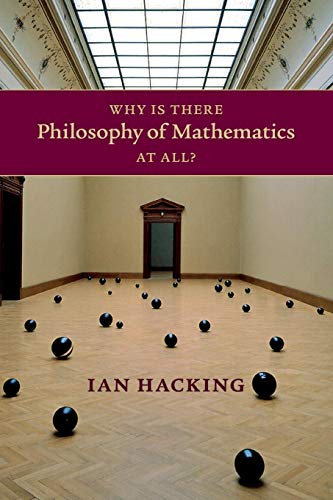why philosophy mathematics von hacking ian (10 Ergebnisse)
FeedbackSuchfilter
Produktart
- Alle Product Types
- Bücher (10)
- Magazine & Zeitschriften (Keine weiteren Ergebnisse entsprechen dieser Verfeinerung)
- Comics (Keine weiteren Ergebnisse entsprechen dieser Verfeinerung)
- Noten (Keine weiteren Ergebnisse entsprechen dieser Verfeinerung)
- Kunst, Grafik & Poster (Keine weiteren Ergebnisse entsprechen dieser Verfeinerung)
- Fotografien (Keine weiteren Ergebnisse entsprechen dieser Verfeinerung)
- Karten (Keine weiteren Ergebnisse entsprechen dieser Verfeinerung)
- Manuskripte & Papierantiquitäten (Keine weiteren Ergebnisse entsprechen dieser Verfeinerung)
Zustand
Einband
Weitere Eigenschaften
- Erstausgabe (Keine weiteren Ergebnisse entsprechen dieser Verfeinerung)
- Signiert (Keine weiteren Ergebnisse entsprechen dieser Verfeinerung)
- Schutzumschlag (Keine weiteren Ergebnisse entsprechen dieser Verfeinerung)
- Angebotsfoto (3)
Sprache (1)
Preis
- Beliebiger Preis
- Weniger als EUR 20 (Keine weiteren Ergebnisse entsprechen dieser Verfeinerung)
- EUR 20 bis EUR 45
- Mehr als EUR 45
Gratisversand
Land des Verkäufers
Verkäuferbewertung
-
WHY IS THERE PHILOSOPHY OF MATHEMATICS A
Verlag: Cambridge University Press, 2014
ISBN 10: 1107658152 ISBN 13: 9781107658158
Sprache: Englisch
Anbieter: Speedyhen, London, Vereinigtes Königreich
EUR 28,95
Währung umrechnenEUR 5,74 für den Versand von Vereinigtes Königreich nach DeutschlandAnzahl: 2 verfügbar
In den WarenkorbZustand: NEW.
-
Why Is There Philosophy of Mathematics At All?
Verlag: Cambridge University Press, 2014
ISBN 10: 1107658152 ISBN 13: 9781107658158
Sprache: Englisch
Anbieter: AHA-BUCH GmbH, Einbeck, Deutschland
EUR 36,20
Währung umrechnenKostenlos für den Versand innerhalb von/der DeutschlandAnzahl: 2 verfügbar
In den WarenkorbTaschenbuch. Zustand: Neu. Druck auf Anfrage Neuware - Printed after ordering - This truly philosophical book takes us back to fundamentals - the sheer experience of proof, and the enigmatic relation of mathematics to nature. It asks unexpected questions, such as 'what makes mathematics mathematics ', 'where did proof come from and how did it evolve ', and 'how did the distinction between pure and applied mathematics come into being ' In a wide-ranging discussion that is both immersed in the past and unusually attuned to the competing philosophical ideas of contemporary mathematicians, it shows that proof and other forms of mathematical exploration continue to be living, evolving practices - responsive to new technologies, yet embedded in permanent (and astonishing) facts about human beings. It distinguishes several distinct types of application of mathematics, and shows how each leads to a different philosophical conundrum. Here is a remarkable body of new philosophical thinking about proofs, applications, and other mathematical activities.
-
Why Is There Philosophy of Mathematics At All?
Verlag: Cambridge University Press, 2014
ISBN 10: 1107658152 ISBN 13: 9781107658158
Sprache: Englisch
Anbieter: moluna, Greven, Deutschland
EUR 37,47
Währung umrechnenKostenlos für den Versand innerhalb von/der DeutschlandAnzahl: 2 verfügbar
In den WarenkorbZustand: New. Ian Hacking draws on cognitive sciences, evolutionary psychology, neurology, developmental psychology, and cognitive archaeology (tools and the mind) to explore how mathematics became possible, for a species like ours, on a planet like this. An innovative b.
-
Why Is There Philosophy of Mathematics At All?
Verlag: Cambridge University Press, 2014
ISBN 10: 1107658152 ISBN 13: 9781107658158
Sprache: Englisch
Anbieter: Ria Christie Collections, Uxbridge, Vereinigtes Königreich
EUR 34,83
Währung umrechnenEUR 5,73 für den Versand von Vereinigtes Königreich nach DeutschlandAnzahl: Mehr als 20 verfügbar
In den WarenkorbZustand: New. In.
-
Why Is There Philosophy of Mathematics at All?
Anbieter: Revaluation Books, Exeter, Vereinigtes Königreich
EUR 35,79
Währung umrechnenEUR 11,51 für den Versand von Vereinigtes Königreich nach DeutschlandAnzahl: 2 verfügbar
In den WarenkorbPaperback. Zustand: Brand New. 304 pages. 9.00x6.25x0.75 inches. In Stock.
-
Why is There Philosophy of Mathematics at All?
Verlag: Cambridge University Press, 2014
ISBN 10: 1107658152 ISBN 13: 9781107658158
Sprache: Englisch
Anbieter: Kennys Bookstore, Olney, MD, USA
EUR 46,62
Währung umrechnenEUR 1,89 für den Versand von USA nach DeutschlandAnzahl: 2 verfügbar
In den WarenkorbZustand: New. . 2014. First Edition. Paperback. . . . . Books ship from the US and Ireland.
-
Why Is There Philosophy of Mathematics At All?
Verlag: Cambridge University Press, 2014
ISBN 10: 1107050170 ISBN 13: 9781107050174
Sprache: Englisch
Anbieter: Labyrinth Books, Princeton, NJ, USA
EUR 52,96
Währung umrechnenEUR 14,57 für den Versand von USA nach DeutschlandAnzahl: 1 verfügbar
In den WarenkorbZustand: Very Good.
-
Why Is There Philosophy of Mathematics At All?
Verlag: Cambridge University Press, 2014
ISBN 10: 1107050170 ISBN 13: 9781107050174
Sprache: Englisch
Anbieter: Ria Christie Collections, Uxbridge, Vereinigtes Königreich
EUR 100,95
Währung umrechnenEUR 5,73 für den Versand von Vereinigtes Königreich nach DeutschlandAnzahl: Mehr als 20 verfügbar
In den WarenkorbZustand: New. In.
-
Why Is There Philosophy of Mathematics at All?
Anbieter: Revaluation Books, Exeter, Vereinigtes Königreich
EUR 136,88
Währung umrechnenEUR 11,51 für den Versand von Vereinigtes Königreich nach DeutschlandAnzahl: 2 verfügbar
In den WarenkorbHardcover. Zustand: Brand New. 290 pages. 9.00x6.25x1.00 inches. In Stock.
-
Why Is There Philosophy of Mathematics At All?
Verlag: Cambridge University Press, 2014
ISBN 10: 1107050170 ISBN 13: 9781107050174
Sprache: Englisch
Anbieter: AHA-BUCH GmbH, Einbeck, Deutschland
EUR 148,76
Währung umrechnenKostenlos für den Versand innerhalb von/der DeutschlandAnzahl: 1 verfügbar
In den WarenkorbBuch. Zustand: Neu. Druck auf Anfrage Neuware - Printed after ordering - This truly philosophical book takes us back to fundamentals - the sheer experience of proof, and the enigmatic relation of mathematics to nature. It asks unexpected questions, such as 'what makes mathematics mathematics ', 'where did proof come from and how did it evolve ', and 'how did the distinction between pure and applied mathematics come into being ' In a wide-ranging discussion that is both immersed in the past and unusually attuned to the competing philosophical ideas of contemporary mathematicians, it shows that proof and other forms of mathematical exploration continue to be living, evolving practices - responsive to new technologies, yet embedded in permanent (and astonishing) facts about human beings. It distinguishes several distinct types of application of mathematics, and shows how each leads to a different philosophical conundrum. Here is a remarkable body of new philosophical thinking about proofs, applications, and other mathematical activities.






